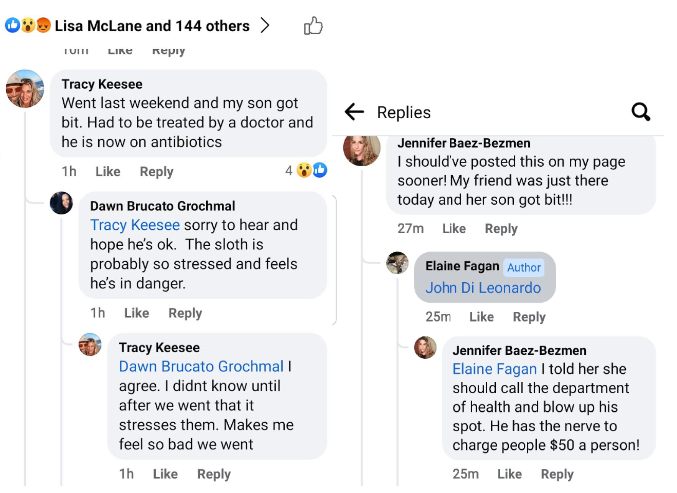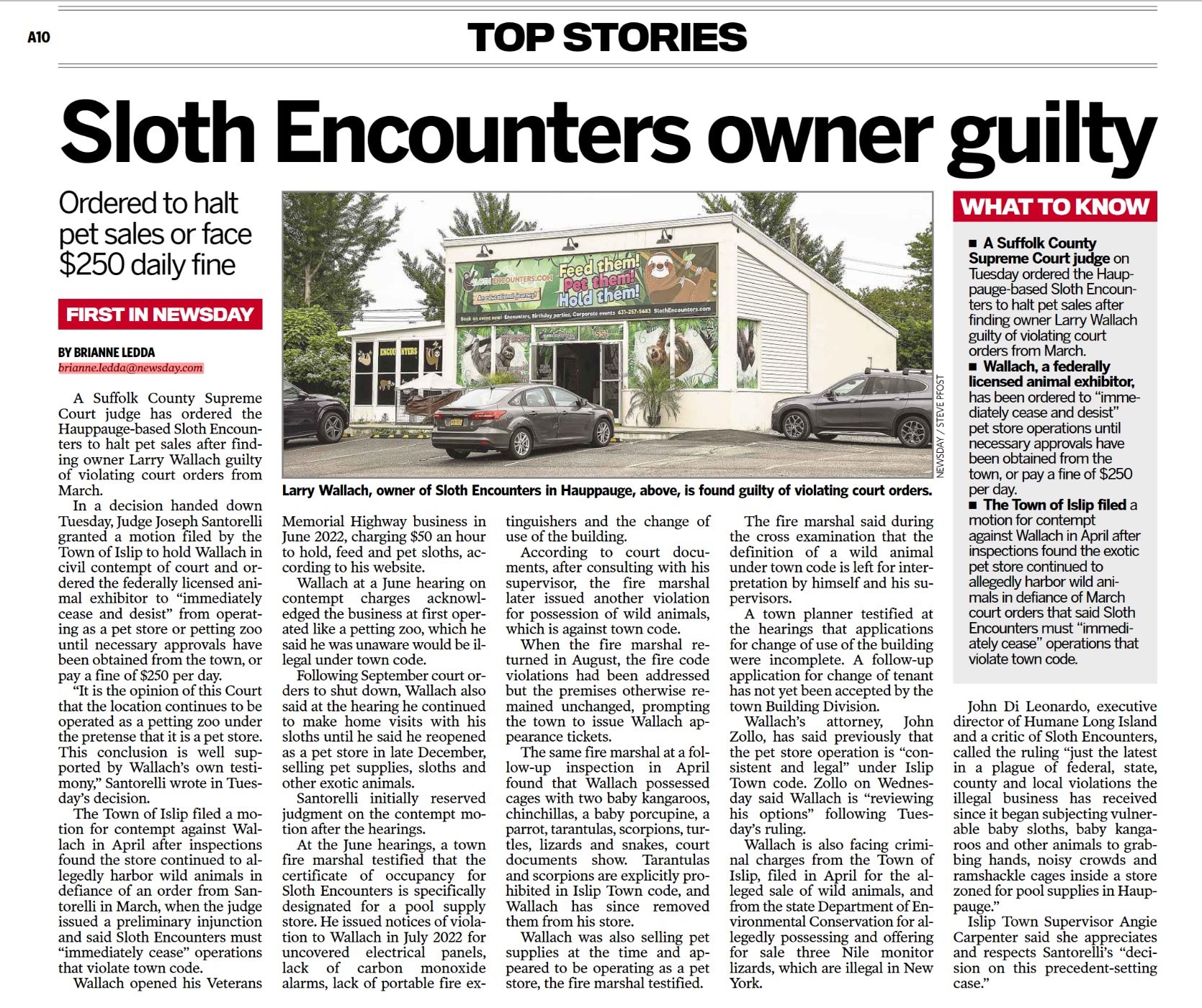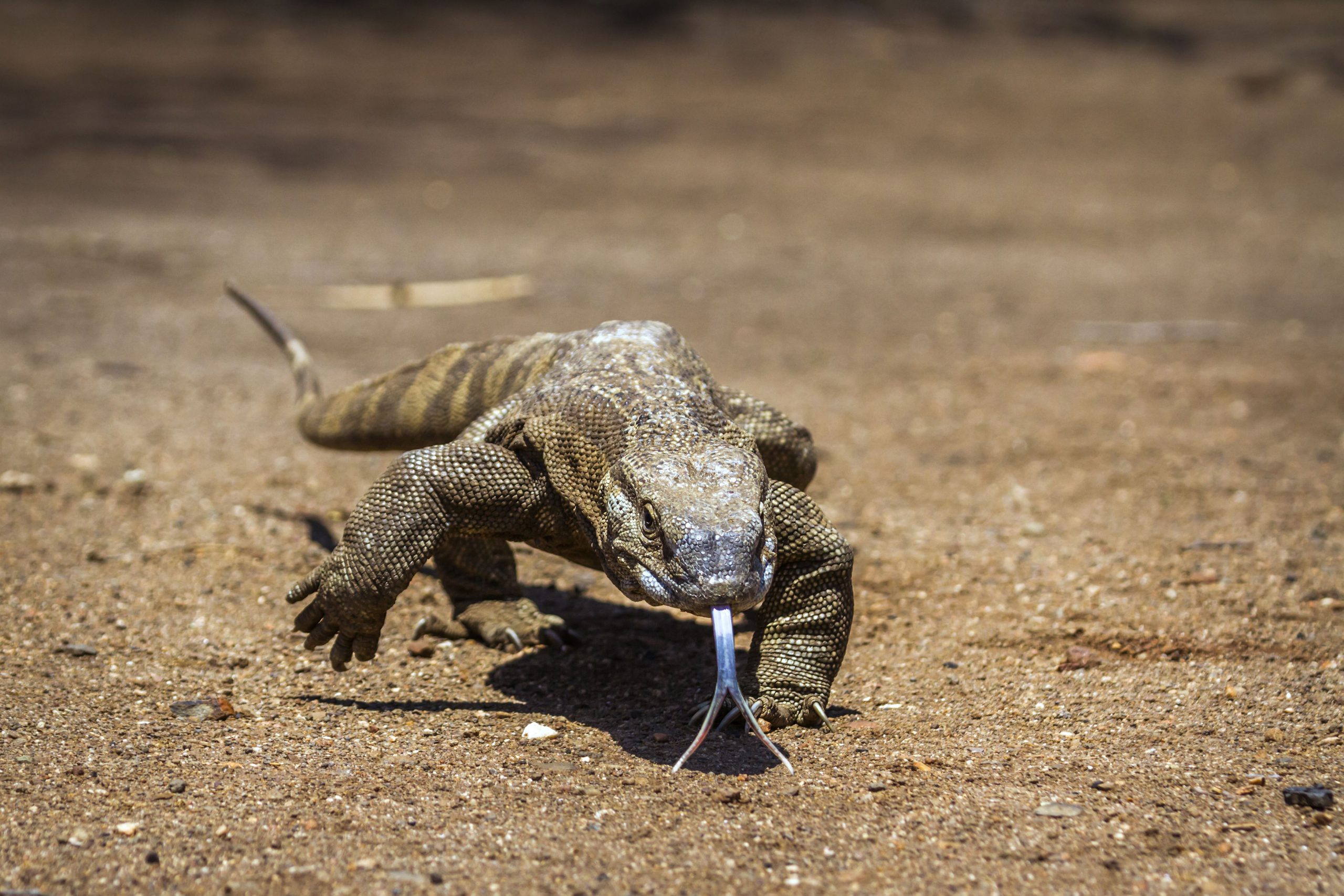
Take Action:
After you read about Larry Wallach and his illegal business, please take the following steps to help the sloths, kangaroos, and other animals imprisoned at Larry Wallach's Sloth Encounters in Hauppauge:
- Contact Islip Supervisor Angie Carpenter at (631) 224-5500 and [email protected] to urge her to shut down Sloth Encounters now!
- Contact federal authorities at [email protected] to urge them to revoke Wallach's license (#21-C-0069) for failing to abide by local laws. It was just renewed despite Wallach failing to abide by local laws.
- Support our campaign for a more humane Long Island by becoming a one-time or monthly supporter!
Donate - Contact [email protected] with evidence of Sloth Encounters' upcoming or recently past exhibitions. Exhibiting sloths, kangaroos, and other wild animals is illegal in Suffolk County, New York City, Oyster Bay, Hempstead, and indoor dining areas anywhere in the state.
Then join our Action Team to learn about more opportunities to help sloths and other animals suffering on Long Island.


Who are sloths?
Sloths are solitary, tree-dwelling animals with sharp teeth and four-inch claws. Native to tropical rainforests, they are the slowest moving mammal on the planet, are mostly deaf, and nearly blind when exposed to bright daylight.
According to Rebecca Cliffe, PhD, a Costa Rica-based zoologist who founded the Sloth Conservation Foundation, a non-profit dedicated to saving sloths in the wild:
Allowing hands-on contact is not ethical. Sloths are a solitary species, so they’re not social and can’t be domesticated. They are the prey and humans are the predator. Sadly, their natural reaction is to stay still, which confuses people into thinking they are content with being held and touched. And there’s another entirely separate issue: the effects of social media.
The more people visiting these encounters and sharing photographs of touching and holding a sloth, the faster these actions become normalized. People then come to economically troubled countries like Costa Rica or Colombia or Brazil with a preconception that sloths are touchable and holdable, which then presents greater opportunities for exploitation.
What is Sloth Encounters Long Island?
Sloth Encounters is a petting zoo and exotic animal "pet" store operating unlawfully in the Town of Islip, New York. Sloth Encounters subjects wild animals, including vulnerable baby sloths, kangaroos, porcupines, and capybaras to grabbing hands, noisy crowds, and ramshackle cages inside a store zoned for pool supplies. Its owner Larry Wallach has a long history of animal mistreatment, and his latest misadventure has been plagued with federal, county, and local violations from the moment it opened its doors.
Since July 2023, Wallach's been cited for violations of the federal Animal Welfare Act, pleaded guilty to trafficking Nile monitors—venomous reptiles who grow up to 7ft long—and been found guilty of contempt for violating Supreme Court orders enjoining him from operating.
Wallach's violations have spurred both a new Suffolk County law banning traveling exotic animals and new state legislation looking to ban the sale of these animals to the public, however, despite all this, the USDA has continued to renew his license and he's continuing to operate, being busted taking customers through the back of the store—which has been ordered closed by the Supreme Court three times—and bringing them to unlicensed marijuana parties where organizers allege the sloths got "high."
Acording to Denise Flores—an employee of Wallach's late business partner Sam Mazzola—Wallach's illegal cannabis exhibitions weren't the first time Wallach's animals were allegedly drugged, telling Roadside Zoo News:
[Sam] had partnered up with a man named Larry Wallach to open this store and they were bringing in cubs—like a baby white lion and a baby tiger—and Larry was drugging the babies! I caught him. After I saw him drug the cub, I grabbed the baby and stuck my finger down its throat to get it to vomit the drugs up. I confronted Larry about it, but he was one of the bosses. I’m pretty sure they kept drugging the cubs after that.

SLOTH ENCOUNTERS’ STAFF HIT SLOTHS; OWNER GRABBED WOUNDED SLOTH BY THE NECK
Following numerous investigations by Humane Long Island, our colleagues from the Humane Society of the United States joined the fray to release an undercover investigation that captured disturbing footage of Sloth Encounters’ staff hitting sloths, stressed sloths kept in crowded conditions, sloths fighting with one another and a wounded sloth struggling when the unlawful Hauppauge business owner roughly grabbed his head and neck.
Wallach was subsequently cited in February 2024 for violating the federal Animal Welfare Act by improperly handling sloths during public interactions resulting in injuries (a “critical” violation), confining incompatible animals to a single enclosure risking “injury or death of the animals” (a “critical” violation), and leaving facilities in such disrepair that it caused a potential hazard to a kangaroo and two capybaras.
ADDITIONAL ANIMAL WELFARE ACT VIOLATIONS & CHILD ENDANGERMENT ALLEGATIONS
Sloth Encounters’ owner Larry Wallach has been cited for more than fifty violations of the federal Animal Welfare Act, including “critical” violations for lying to USDA inspectors about an incident involving the bite of a child at his unlawfully operated Hauppauge facility and for mishandling animals in a way that’s dangerous to the public and the animals. According to Suffolk County health officials, had the incident involved one of the other more recently acquired sloths, euthanasia and rabies testing of the sloth would likely have been required for public health purposes. Kangaroos, unlike dogs and sloths, cannot be vaccinated against rabies. Without prompt treatment, rabies is almost always fatal in humans.

In October 2022, Wallach was cited for two more violations of the Animal Welfare Act after he failed to show USDA inspectors a veterinary care plan for a baby sloth and told inspectors that the sloths stay at his brother or girlfriend’s house when the facility is closed, when in fact he was harboring them at the Best Western Mill River Manor in Rockville Centre. After Best Western’s corporate office was informed that Wallach was hiding sloths from federal authorities at this location, Wallach was ordered to remove them and vacated the hotel. Wallach then began staying with an employee who was squatting in a New York City apartment. Shortly thereafter, the Administration of Children‘s Services took custody of two children belonging to that Sloth Encounters employee after it apparently found she had endangered them by exposing them to dangerous, wild animals at Sloth Encounters.
Wallach was cited again by the USDA in March 2023 for not providing federal inspectors access to inspect his facility; and again, in April 2023 for mishandling animals after a USDA inspector observed an employee improperly feeding a baby kangaroo in a manner that “can lead to aspiration and accompanying aspiration pneumonia” and after a sloth was observed attempting to bite Wallach and patrons.
Wallach was yet again cited for violations of the Animal Welfare Act in August 2023 after failing to keep a written program of veterinary care for kangaroos, capybaras, a chinchilla, and a sugar glider; and for keeping the sloths in an enclosure with humidity insufficient for their health and welfare, leading to a baby sloth named Cosmo to scratch at his skin.
https://youtu.be/xCe19sw1tcU?si=D6qskSPyYNg8c75O
In October 2023, Wallach was cited for failing to maintain “a safe and effective program for the control of insects, ectoparasites, avian and mammalian pests” after “a large number of flies were seen in the store front (housing the capybaras and kangaroo), sloth exhibit area, and kitchen.”
TOWN OF ISLIP CHARGES & CONTEMPT OF SUPREME COURT
The Suffolk County Health Department has cited Sloth Encounters for operating without a permit and the Town of Islip has issued Sloth Encounters and its landlord 777 Chris’s Way, LLC criminal court appearance tickets for possession of wild animals, occupancy of a building without fire marshal approval, prohibited use, and change of use without a permit.
The Suffolk County Supreme Court has also granted Islip both a Temporary Restraining Order and a Preliminary Injunction enjoining Sloth Encounters from operating unlawfully while the court considers a permanent injunction to shutter the business, however, Wallach has not only continued to illegally exhibit sloths in Islip but has hauled them on the road and expanded his illicit business to exploit baby kangaroos, porcupines, bearcats, and other animals who are also illegal in the township.
In contempt of court filings, Islip’s attorney wrote that the business is displaying “blatant disobedience and unwillingness to comply with court order … The Defendants are recidivists. They are determined to do whatever they want without regard for the law, the consequences of their actions, or the efforts of municipal authorities or this Court to stop them.”
On July 11, 2023, the Suffolk County Supreme Court found Sloth Encounters and its landlord 777 Chris’s Way, LLC guilty of civil contempt of court, ordering that Sloth Encounters must:
immediately cease and desist from operating the subject premises as a ‘pet store’ or petting zoo” and that “the defendants shall be fined the sum of $250.00 per day, payable to the Town, for each day the defendants continue to operate as a pet store or petting zoo in violation of the March 30, 2023, Order of the Court.

Wallach and his landlord now owe the Town of Islip approximately $120,000 in uncollected fines due to their continued operation.
GUILTY OF INTERSTATE WILDLIFE TRAFFICKING
In addition to his local charges, Wallach recently pleaded guilty to state charges of illegal possession with intent to sell Nile monitors—venomous reptiles who grow up to 7ft long. The district attorney’s office sought incarceration, however, the Honorable Judge Jonathan Bloom sentenced Wallach to only a $250 fine plus a $25 surcharge, basically the cost of doing business.
Nile Monitors are listed as Dangerous Animals as defined by Title 6 New York Codes, Rules, and Regulations 180.1. They require a Dangerous Animals permit, which Wallach does not have after the DEC failed to renew his permit last year due to previous infractions.

YOUNG TIGER ELECTROSHOCKED & LICENSES SUSPENDED, DENIED
Sloth Encounters is not Larry’s Wallach’s first run-in with the law. Larry Wallach has racked up more than 60 citations from federal authorities, countless local citations, and even received a 6-month suspension of his USDA license in 2013. The DEC failed to renew his license to exhibit certain “dangerous animals”, such as lions, tigers, and bears, following his chronic and blatant disregard for animal welfare and public safety, which is apparently why he’s now exhibiting sloths who are not subject to that permit requirement.
In 2021, the U.S. Department of Agriculture cited Wallach after finding a sloth in his cluttered garage with hazards in and around the animal’s enclosure that “could injure the animal by burning, broken glass, or electrical shock.” The agency also cited a roadside zoo in Ohio after a tip from PETA that Wallach, holding an electric prod and accompanied by a dog, entered the cage of a young tiger he had dumped there after she outgrew the dilapidated cage that he had kept her in under the deck of his Nassau County residence.
The USDA previously cited Wallach for an incident in which he took an unrestrained tiger cub to a public park and allowed the public to pet and handle the animal. A tip from PETA about Facebook Live videos—one of which depicted Wallach electroshocking a young tiger named Sheba and threatening a dog with an electric prod—resulted in a slew of citations, including a “critical” citation for failure to follow veterinary instructions for treatment of Sheba’s broken toe, and further citations for confining her to an enclosure in disrepair that had broken floorboards, and putting her and a wolf at risk of injury by allowing them to interact in a dangerous manner.
WHAT HUMANE LONG ISLAND IS DOING TO HELP

-
PROTESTS AND OFFICIAL COMPLAINTS
Public protests and official complaints filed by Humane Long Island have resulted in Larry Wallach being cited for “critical” violations of the Animal Welfare Act, pleading guilty to wildlife trafficking charges, being held in contempt of court, and the cancelation of upcoming exhibitions.
You too can urge authorities to stop moving at a sloth’s pace and take action by contacting the USDA and Islip Supervisor Angie Carpenter at the links below. Please urge Supervisor Carpenter to notify the Supreme Court of Wallach’s violations of court orders and urge the USDA to revoke Wallach’s license (#21-C-0069) for failing to abide by local laws.
Islip Supervisor Angie Carpenter can also be reached by phone at (631) 224-5500.
-
LOBBYING TO RESTRICT TRAVELING WILD ANIMAL ACTS AND CLOSE LOOPHOLES IN STATE LAW
Humane Long Island recently worked with lawmakers to restrict traveling exotic animal acts across Suffolk County. We’re now working with Senator Monica Martinez on legislation to ban the sale of certain exotic animals to the public. Senator Martinez’s 2023 bill passed nearly unanimously in the Senate but will need to be reintroduced with an Assembly companion bill in 2024. Sign up for our newsletter to be alerted when these bills are reintroduced.
On Jamie Fullerton's Beast Master podcast, Wallach confessed:
If the people in the animal world weren't so cuckoo, we would get away with so much!
Don't let Wallach con you. To file a complaint about Larry Wallach or Sloth Encounters with Humane Long Island, e-mail us at [email protected].